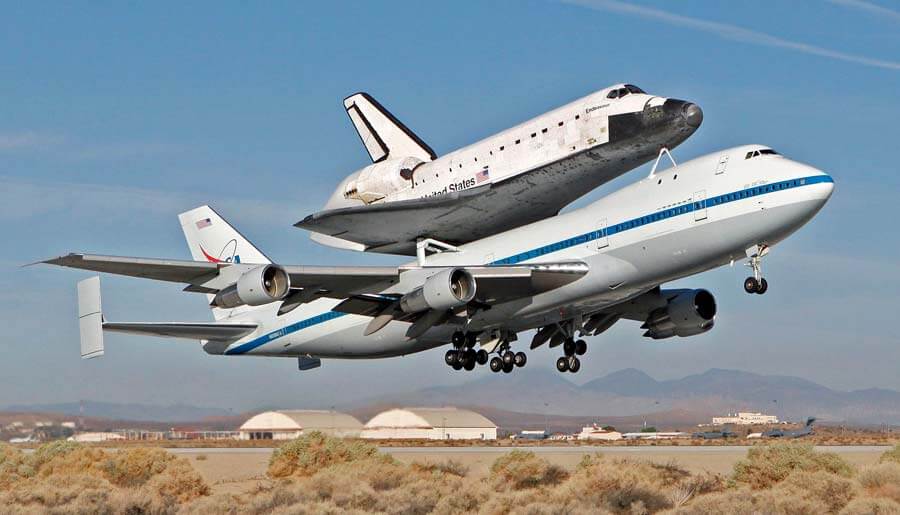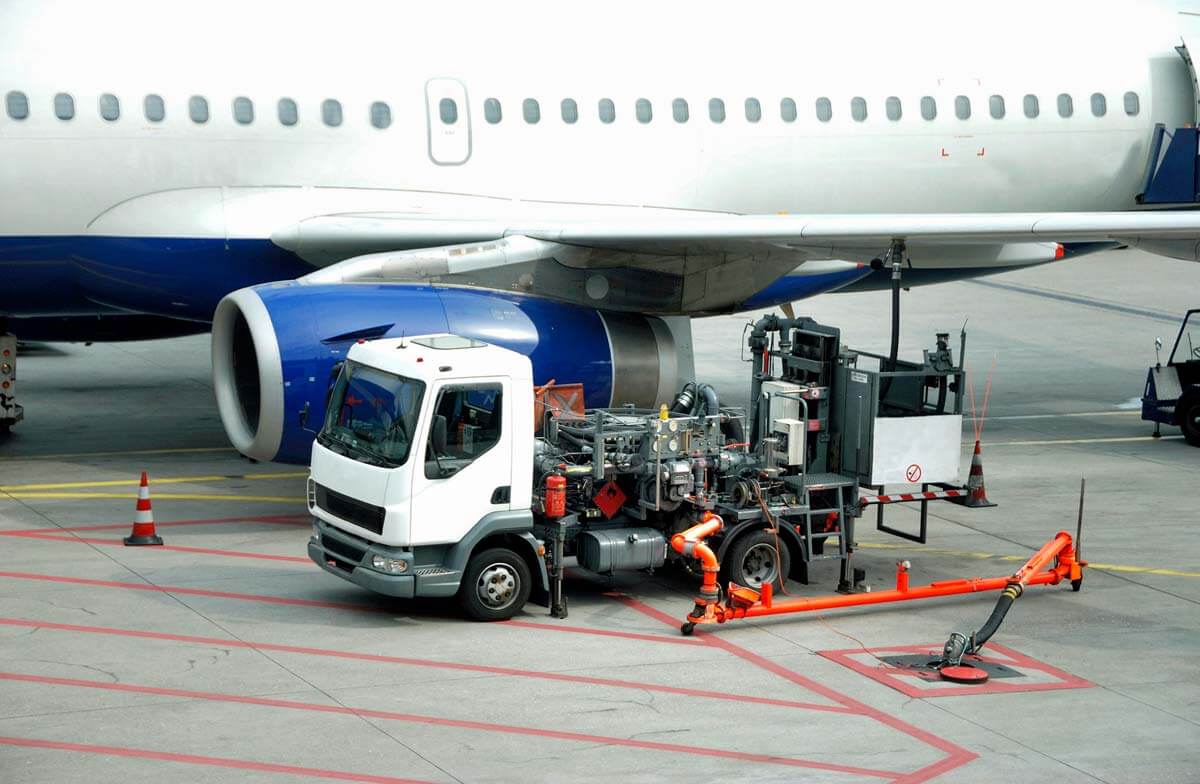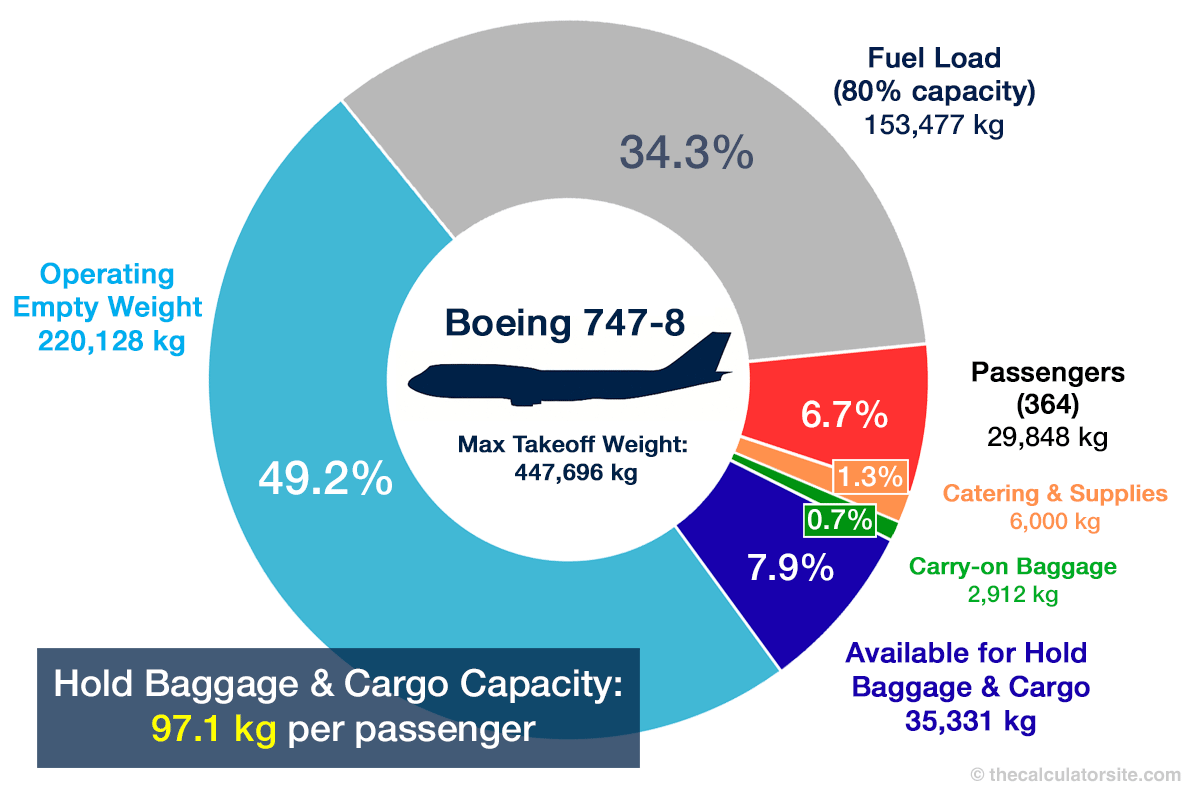Airline Baggage Weight - Why Does It Matter?
Why do airlines obsess over every kilogram in your suitcase, whilst Boeing 747s can literally carry space shuttles? This deep dive into aviation physics reveals some surprising - and slightly disturbing - truths about baggage limits, passenger weight, and airline economics.
Let's begin with a photograph...

The idea for this article started with a flippant Facebook post. It featured the photo above and a caption that (stripping out the swear words) read:
"This plane is carrying a ******* spaceship. Why do I have a 50 lb. limit on my ******* suitcase?"
This set us to thinking: are aviation baggage limits actually linked to aircraft capacity or are they just a useful extra revenue earner for airlines? With our passion for calculations and getting to the numerical truth of things, we decided to work through the maths properly.
Well, we've done the calculations and the results are quite surprising - even a little disturbing. They perhaps back up Samoa Air's decision to be the first airline in the world to charge customers by body weight as well as luggage weight in 2013. Some industry sources claimed this concept could be the future for air fares.
More than a decade later, whilst Samoa Air remains largely alone in direct weight-based charging, the underlying physics concerns have prompted other airlines to take passenger weight seriously. Finnair, Korean Air, and Air New Zealand have all conducted voluntary passenger weighing programmes in recent years - not for charging purposes, but to improve their weight distribution calculations and safety margins. 1
Aircraft carrying a space shuttle
Let's start with that Shuttle Orbiter, whose dry weight was around 78,000 kilos (Like most airlines, we'll keep all the numbers metric: it makes life a lot easier).

The carrier aircraft is a Boeing 747 SCA (Shuttle Carrier Aircraft), modified from a standard Boeing 747-100. To equip the aircraft for its new role, Boeing stripped out most of the main cabin fixtures and insulation (though keeping a few first-class seats for NASA passengers), added some mounting struts and beefed up the fuselage.
They also added some extra vertical stabilisers to keep the thing flying straight with the Orbiter on top, as well as some more powerful engines. They even added an escape tunnel system for the flight crew (although they had to remove it later, after it became clear that the escape trajectory was unlikely to take the hopeful parachutist much further than the fan blades of one of the inboard engines).
Plainly (planely?), these modifications were sufficient to allow a Boeing 747 to carry a 78-tonne spaceship, implying that the basic aircraft could do so as well.
Aircraft fuel calculations
So let's look at the basic data for a Boeing 747-100, which entered service in 1970:
Here's the weight breakdown:
- Maximum takeoff weight: 333,390 kg
- Operating empty weight: 162,400 kg
- Net lifting capacity: 170,990 kg - still enough to carry almost three Orbiters!
But that's before you've added fuel. Jet aircraft are incredibly thirsty and therefore require huge amounts of fuel. The 747-100B had a maximum fuel capacity of 183,380 litres (enough to give it a range of 5,300 nautical miles (6,100 miles or 9,800 kilometres).

In order to calculate the weight of a maximum fuel load, we need to find out what kind of fuel was used and then apply a conversion factor. Your basic common or garden jet fuel is Jet A or Jet A1, with a density on the ground of 0.804 kg per litre. Now let's see what happens to our capacity:
- Net lifting capacity: 170,990 kg
- Maximum fuel weight: 147,500 kg (183,380 litres)
- Actual payload capacity: 23,490 kg
- Final payload: 23,490 kg
Suddenly, that lifting capacity isn't looking so generous after all! All of which explains why even the stripped-out SCA had a very short range, having to go coast to coast in hops of little more than 1,000 miles at a time with the shuttle on top.
Weight and load calculations
And how does that net payload of 23.49 metric tonnes cope with long-haul airline service? The short answer is - it doesn't. Let's work through a realistic scenario:
- Available payload: 23,490 kg
- In-flight catering and supplies (average of 40,000 items): 6,000 kg
- Remaining for passengers and baggage: 17,490 kg
With just 17 tonnes left in hand, we're finally ready to start loading passengers and baggage for our notional flight from London Heathrow to Los Angeles LAX (5,440 miles), for which we're going to require almost a full fuel load.
Airlines don't like to make passengers get on the scales at the Check-in Desk, so they work to standardised weight assumptions. Based on EASA's latest 2022 survey data, you're looking at 82.2kg per male, 67.5kg per female, and 30.4kg per child (up to age 12). Carry-on baggage averages 7.7kg for adults and 2.2kg for children. 2
In airline trim, the 747-100 could carry 420 passengers in two classes or 366 in three classes. 3 Plainly, that first configuration isn't going to work for London to LA. Let's see why:
- Available capacity: 17,490 kg
- 420 passengers (218 male, 176 female, 26 minors): 30,590 kg
- Overweight by: 13,100 kg - even with everyone bare-ass naked!
(For those unfamiliar with airline jargon: airline "classes" refer to service levels such as Economy, Premium Economy, Business, and First Class. Premium classes use much more space per passenger, so fewer people fit aboard. Modern long-haul aircraft typically offer two to four classes, with premium configurations significantly reducing total passenger capacity.)
In a three-class configuration, we might have better luck:
- Available capacity: 17,490 kg
- 366 passengers (179 male, 151 female, 36 minors): 26,001 kg
- Overweight by: 8,511 kg - still impossible, even without luggage!
Even with fewer passengers, we're still overweight - and that's before anyone packs so much as a toothbrush. Each passenger and crew member has carry-on baggage: adults average 7.7kg and children 2.2kg. Let's add this:
Adding baggage
- Available capacity: 17,490 kg
- 366 passengers (body weight): 26,001 kg
- Carry-on baggage: 2,620 kg
- Total overweight: 11,131 kg
Then you have the hold bags. If you allow each of the 275 Economy passengers one suitcase at 30kg and each of the 91 Business/First Class passengers two hold bags at 50kg each:
- Economy hold bags: 8,250 kg (275 × 30kg)
- Premium hold bags: 9,100 kg (91 × 100kg)
- Total hold baggage: 17,350 kg
- Grand total overweight: 28,481 kg
We're now nearly 30 tonnes overweight and will have to offload close to 37,000 litres of fuel to get airborne. Forget LA - we might make Chicago O'Hare.
But why did Boeing's engineers face these impossible equations? The answer lies in the 747-100's fundamental engineering constraints. Those original engines produced just 43,500 pounds of thrust each - compared to the modern 747-8's massive 66,500 pounds per engine, a 53% increase in power. 1011
With insufficient thrust to handle heavy loads, Boeing was forced into desperate weight-saving measures throughout the aircraft. Every component was stripped to the minimum, every system pared down, every ounce scrutinised. Airlines couldn't simply fuel up and fly - they had to choose between passengers and range, between baggage and physics.
Real-world weight limits in action
This isn't just theoretical number-crunching, either. In July 2023, passengers on an EasyJet flight from Lanzarote to Liverpool got a stark lesson in aviation physics when the pilot announced the aircraft was too heavy to take off safely. The solution? Nineteen volunteers accepted up to €500 each to take a later flight, whilst everyone else sat around for nearly two hours as the crew rebalanced the aircraft.
EasyJet's response was telling: they described this as a "routine operational decision for safety." In other words, when the sums don't add up, passengers get bumped - because Newton's laws aren't open to negotiation at 35,000 feet.
Modern aircraft baggage capacity
So how do they manage to get long-haul aircraft into the air?
Basic answer, the 747-100 wasn't a genuine long-haul jumbo. It could do max fuel or max passengers, but not both. In really long-haul mode, it would have been restricted to more like 220 passengers in three classes.
But that's not the whole story. Early 747 operations involved significant compromises that modern passengers would find unacceptable:
- Fuel stops were common - many long-haul routes required intermediate stops, with airlines like BA initially refusing direct London-LAX service due to range concerns 5
- Stricter weight management - airlines had less margin for error with baggage and passenger loads
- Route limitations - some ultra-long routes weren't viable with full passenger loads until later variants arrived 56
- Operational planning - airlines had to carefully balance passenger numbers against fuel requirements for longer missions
The 30-tonne overweight scenario from our calculation represents an impossible mission profile. Airlines in the 1970s simply couldn't attempt London-LA direct with 366 passengers and generous baggage allowances. The physics wouldn't allow it.
Modern engineering has completely transformed this equation, however. Advanced engines, composite materials, and improved aerodynamics mean today's aircraft can carry full passenger loads with substantial baggage allowances on intercontinental routes. The 'impossible weight equations' that plagued early jumbos have been definitively solved.
Here's a comparison of the 747-100 with two more modern aircraft: 789
| Aircraft | Boeing 747-100 | Boeing 747-8 | Airbus A380 |
|---|---|---|---|
| Mission Type | Long-haul | Long-haul | Long-haul |
| In Service | 1970-2009 | 2012-present | Current |
| Range (typical) | 9,800 km 6,100 miles |
13,000 km 8,078 miles |
12,400 km 7,705 miles |
| Max Takeoff Weight | 333,390 kg | 447,696 kg | 575,000 kg |
| Operating Empty Weight | 162,400 kg | 220,128 kg | 276,800 kg |
| Typical Mission Fuel Load (80%) | 147,500 kg | 153,477 kg | 205,824 kg |
| Available Payload Subtotal | 23,490 kg | 74,091 kg | 92,376 kg |
| Catering & Supplies | 6,000 kg | 6,000 kg | 10,000 kg |
| Passengers | 366 (26,001 kg) | 364 (29,848 kg) | 525 (43,050 kg) |
| Carry-on Baggage | 2,620 kg | 2,912 kg | 4,043 kg |
| Available for Hold Baggage & Cargo | -11,131 kg | 35,331 kg | 35,283 kg |
| Hold Baggage per Passenger (if no cargo) | Impossible | 97.1 kg | 67.2 kg |
The table tells the story clearly: modern engineering has completely solved the "impossible weight equations" that plagued the 747-100. The 747-8 can carry 97kg of hold baggage per passenger (if no cargo) on long-haul routes, whilst the A380 manages 67kg per passenger - both generous theoretical allowances compared to the original 747-100, which couldn't even get off the ground with a full passenger load and fuel tanks.
The contrast is stark: early jumbos faced fundamental physics limitations, whilst today's aircraft offer substantial capacity for passenger baggage and commercial cargo on intercontinental routes.

But even with these improved margins, weight management remains critical for safety reasons. Aircraft still need careful weight distribution to avoid stressing the airframe, preserve manoeuvrability, and ensure safe emergency landings. Modern margins exist, but they're carefully calculated - not arbitrary.
Safety calculations for aircraft
One final point - what happens if the aircraft gets into trouble and has to make an emergency landing? Maximum landing weights are a lot less generous than maximum take-off weights (312,072 kg for the 747-8 compared to its 447,696 kg takeoff weight). 4
And while the crew might be able to dump fuel, they won't be able to lighten the aircraft any other way. They might need to dump a lot of fuel, too, because the aircraft isn't going to make it back down in one piece with anything much over a quarter fuel load in the tanks.
So whilst modern aircraft like the 747-8 have finally solved the impossible weight equations that plagued early jumbos, airlines still need to manage every kilogram carefully. Those generous baggage allowances exist because the physics **finally** works - but there's no spare capacity for passengers to take liberties with weight limits.
All of which leads one to a couple of basic conclusions.
The first is that baggage weight still matters - just not for the catastrophic reasons that applied to primitive aircraft like the 747-100. Modern airlines have margins to work with, but they use every gram for cargo revenue and safety reserves.
The second is that the one phrase you will never hear in civil aviation on the refuelling stand is: "Fill 'er up, mate".
Written by Nick Valentine and Alastair Hazell
Question from visitor
I've never heard of any fatal crashes where a "failure to weigh baggage accurately or load it properly" was found to be a prime cause of the crash. Can you elaborate?
Reply
Yes, there have been several fatal air crashes caused by failure to manage baggage or cargo loads properly. One of the first in modern history was the crash of an Avro 689 Tudor V on March 12, 1950, as it t was approaching Llandow Airport, Cardiff, at the end of a charter flight carrying rugby fans home from Dublin, Ireland. The aircraft was approaching the runway with the undercarriage lowered when it abruptly pitched up, stalled and plunged into the ground, some 2,500 ft. short of the runway threshold. Only three of the 83 people aboard survived. The investigation revealed that the aircraft was not loaded correctly with centre of gravity at least 9 ft. behind the aft limit. This became critical when flaps were lowered, shifting C of G even further aft.
Perhaps the most (in)famous air crash concerning excess baggage weight was that of Arrow Air Flight 1285, a Douglas DC-8 jetliner on a charter carrying US troops from Cairo, Egypt, to their home base in Fort Campbell, Kentucky, via Cologne, West Germany, and Gander, Canada. On the morning of Thursday, 12 December 1985, shortly after takeoff from Gander, the aircraft stalled, crashed, and burned killing all 248 passengers and eight crew — one of the deadliest single air accidents in history. The Canadian Aviation Safety Board (CASB) investigation determined probable primary cause as ice build-up on the wings with underestimated onboard baggage weight as a significant contributory factor (the soldiers' baggage was calculated using standard passenger scales, when returning from tour they were carrying much heavier military loads).
More recent and less controversial instances of excess baggage weight causing loss of an aircraft include:
January 2003: US Airways Express flight 5481, a Beech 1900d commuter aircraft, crashes on takeoff from Charlotte, N.C., found to be 400 to 1,000 pounds overweight, with two exceptionally heavy bags loaded in the tail baggage compartment.
August 25, 2001: The air accident that killed R'nB singer Aaliyah and eight others. The report from Bahamian investigators released by the National Transportation Safety Board found that the twin-engined Cessna 402B was "significantly overloaded" when it crashed shortly after take-off from Marsh Harbour Airport, Bahamas. They found the plane with baggage, fuel and passengers was substantially exceeded permitted gross takeoff weight and again the Cessna was out of balance with too much weight in the tail area.
There have also been accidents caused by failure to secure loads properly, notably loss of a chartered National Airlines Boeing 747 Freighter N949CA that crashed on take-off from Bagram Air Base, Afghanistan, on 29 April 2013. NTSB investigation determined that the rearmost of five armoured military vehicles shifted rearward because it was inadequately restrained, sending the aircraft into an irrecoverable nose up attitude.
In general, though, dangerously excess baggage or cargo weights mainly affect smaller and prop-driven aircraft due to their lower power reserves (a 747 can actually fly, though not take off, on just one engine) and also usually appears as a contributory factor, combined with loss of lift or control impairment from some other cause.
References
- Airlines Weighing Passengers - Real Or Rumor?. Cabin Zero
- EASA review of standard passenger weights. EASA
- Boeing 747-100SR. Simply Flying
- Boeing 747-8 Specifications. Boeing
- BOAC B707-436 Early LAX operations. PPRuNe
- Question about 747-100 range. Airliners.net
- Boeing 747-8 Fleet Information. Lufthansa Group
- Airbus A380 Facts and Figures. Airbus
- Airbus A380. Airlines Inform
- Startup - 747-100. Boeing
- Boeing 747-8 technical description & cutaway. FlightGlobal
